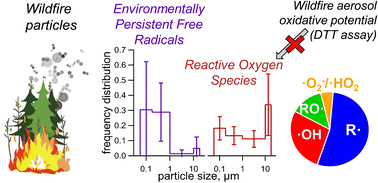Wildfire particulate matter as a source of environmentally persistent free radicals and reactive oxygen species†
Abstract
Wildfires, which have been occurring increasingly in the era of climate change, emit massive amounts of particulate matter (PM) into the atmosphere, strongly affecting air quality and public health. Biomass burning aerosols may contain environmentally persistent free radicals (EPFRs, such as semiquinone radicals) and redox-active compounds that can generate reactive oxygen species (ROS, including ·OH, superoxide and organic radicals) in the aqueous phase. However, there is a lack of data on EPFRs and ROS associated with size-segregated wildfire PM, which limits our understanding of their climate and health impacts. We collected size-segregated ambient PM in Southern California during two wildfire events to measure EPFRs and ROS using electron paramagnetic resonance spectroscopy. EPFRs are likely associated with soot particles as they are predominantly observed in submicron particles (PM1, aerodynamic diameter ≤ 1 μm). Upon extraction in water, wildfire PM mainly generates ·OH (28–49%) and carbon-centered radicals (∼50%) with minor contributions from superoxide and oxygen-centered organic radicals (2–15%). Oxidative potential measured with the dithiothreitol assay (OP-DTT) is found to be high in wildfire PM1, exhibiting little correlation with the radical forms of ROS (r2 ≤ 0.02). These results are in stark contrast with PM collected at highway and urban sites, which generates predominantly ·OH (84–88%) that correlates well with OP-DTT (r2 ∼ 0.6). We also found that PM generated by flaming combustion generates more radicals with higher OP-DTT compared to those by smoldering or pyrolysis.

- This article is part of the themed collection: Wildfire impacts on atmospheric composition - Topic Highlight


 Please wait while we load your content...
Please wait while we load your content...